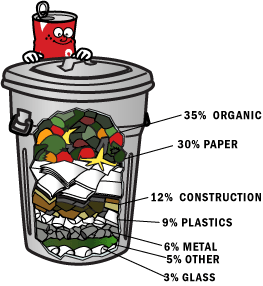
According to the Department of Works and Engineering Bermuda is one of the world’s highest per capita waste generators. We produce approximately 100,000 tonnes of waste annually, or somewhere around 1.5 tonnes per person, per year, and apparently we are still increasing the amount of trash we generate at the rate of 3-4% per year. Bear in mind that we are importing not only all of our clothes, furniture, toys and food, but all of the bags, wrapping, batteries and skins that end up in the bin: we have already paid to import all of the stuff we are now just chucking away.
So, where does it go?
- Firstly: The Tyne’s Bay Waste to Energy Facility, for anything you can incinerate (and of course, quite a few things that you shouldn’t, like all those batteries that end up in the trash);
- Secondly: The Airport Waste Management Facility for cars, bikes, appliances and all the large detritus of our daily lives;
- Thirdly: Marsh Folly for all those branches and leaves that fell off during the hurricane; and
- Finally The MRF, Materials Recycling Facility in Bailey's Bay, better known as the recycling plant.
Here’s the problem: three out of four of these are out of capacity.
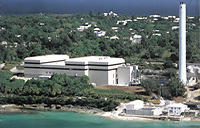 The Tyne’s Bay Waste to Energy Facility That the Tyne’s Bay facility is at crisis point has been discussed quite a bit in the media recently. It was opened in 1994 with two identical mass burn incineration units or ‘streams’. The idea was that we would be able to switch between them as maintenance was needed. However we very rapidly had to use both of them. Everything has a natural lifetime, and you might say that the incinerator is approaching late middle age. It’s estimated lifespan from here is about another 10 years with good care and attention. Budgetary constraints have meant that the planned ‘third stream’, which would have facilitated a normal maintenance program, has been put on indefinite hold. Without the prospect of a third stream maintenance has become critical – and so the government has started a program, which frankly looks like crisis intervention, which will involve shutting off one or both streams for periods of time over the next 1.5 to 2 years. Without full capacity, and in order to prevent trash piling up, the facility will bale trash, wrap it in plastic and store it at Morgan’s point until the facility is fully up and running again.
The Tyne’s Bay Waste to Energy Facility That the Tyne’s Bay facility is at crisis point has been discussed quite a bit in the media recently. It was opened in 1994 with two identical mass burn incineration units or ‘streams’. The idea was that we would be able to switch between them as maintenance was needed. However we very rapidly had to use both of them. Everything has a natural lifetime, and you might say that the incinerator is approaching late middle age. It’s estimated lifespan from here is about another 10 years with good care and attention. Budgetary constraints have meant that the planned ‘third stream’, which would have facilitated a normal maintenance program, has been put on indefinite hold. Without the prospect of a third stream maintenance has become critical – and so the government has started a program, which frankly looks like crisis intervention, which will involve shutting off one or both streams for periods of time over the next 1.5 to 2 years. Without full capacity, and in order to prevent trash piling up, the facility will bale trash, wrap it in plastic and store it at Morgan’s point until the facility is fully up and running again.
OK, several problems here – this is not an awful plan, as long as it all works; however the baler broke down for a while over the summer, resulting in our municipal trash going to Marsh Folly. A short term emergency measure, but much of that trash does not compost, and Mills Creek has it’s own issues (more later). Secondly, do we really think that trucking trash to Morgan’s Point, and then at some point in the next couple of years, trucking it back again, is an efficient way, let alone an environmentally friendly way, to deal with this issue?
 The bunker at the Tyne’s Bay WTE facility
The bunker at the Tyne’s Bay WTE facility
Leaving aside the whole shut-down/maintenance issue, Tyne’s Bay technology is old and rather creaky – it faces regular shut-downs when the emissions of dioxins and furans, or hazardous gases such as SO2, exceed environmental standards. Also it does generate some electricity, so we are not wasting all of the resources that we throw away. Let me be clear that I have nothing against the staff of Tyne’s Bay, they have been completely transparent about the needs of their facility, they adhere to environmental practices, and are doing their best under difficult circumstances. But the situation is dire: to go back to my earlier analogy, this is not a ‘bend over and cough’ checkup, this is more like open heart surgery -- the Tyne’s Bay facility is on life support, and we have no plans for the next generation.
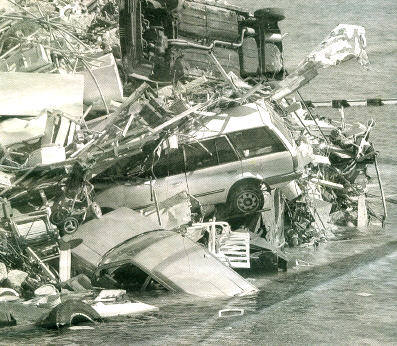 The Airport Waste Management Facility Let’s look briefly at the other routes for our trash: the airport facility is out of space. We are dumping (at a conservative estimate) 10 or more cars a day … think how fast we would fill up Bull’s Head carpark at that rate. These are not crushed, they have the fluids drained and then are dumped. Add to that the bikes, boats, fridges, toilets, and everything else that ends up out there. How long can we keep doing this? Long-standing BIOS research has also demonstrated heavy metal contamination in the mollusks in Castle Harbour, so even if we can keep dumping there, should we?
The Airport Waste Management Facility Let’s look briefly at the other routes for our trash: the airport facility is out of space. We are dumping (at a conservative estimate) 10 or more cars a day … think how fast we would fill up Bull’s Head carpark at that rate. These are not crushed, they have the fluids drained and then are dumped. Add to that the bikes, boats, fridges, toilets, and everything else that ends up out there. How long can we keep doing this? Long-standing BIOS research has also demonstrated heavy metal contamination in the mollusks in Castle Harbour, so even if we can keep dumping there, should we?
![]() The Marsh Folly Composting Facility The Marsh Folly Composting Facility, according to the Department of Works and Engineering, receives horticultural waste, animal carcasses, slaughterhouse waste, swill (commercial kitchen wastes), tree stumps and roots, and used animal bedding. Where there is wet waste there are cats, rats and other vermin. Where there are animals, there are faeces, and therefore e.coli. Inevitably e.coli bacteria have been found in Mills Creek, which lies at the bottom of the facility and passes close to or through the grounds of three schools, and a public (and heavily used) playground. While I am absolutely an advocate of composting (and happily pursue this route on a domestic scale), it is clear that the Marsh Folly facility should not be there in the long term, and possibly not in the short term.
The Marsh Folly Composting Facility The Marsh Folly Composting Facility, according to the Department of Works and Engineering, receives horticultural waste, animal carcasses, slaughterhouse waste, swill (commercial kitchen wastes), tree stumps and roots, and used animal bedding. Where there is wet waste there are cats, rats and other vermin. Where there are animals, there are faeces, and therefore e.coli. Inevitably e.coli bacteria have been found in Mills Creek, which lies at the bottom of the facility and passes close to or through the grounds of three schools, and a public (and heavily used) playground. While I am absolutely an advocate of composting (and happily pursue this route on a domestic scale), it is clear that the Marsh Folly facility should not be there in the long term, and possibly not in the short term.
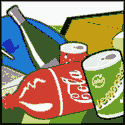 Finally: the MRF, or recycling facility. At last, something with room to spare! This is an excellent and capacious facility at Bailey’s Bay. Unfortunately, it is significantly underused. Only about 25% of Bermudians recycle, and according to the latest audit by the Solid Waste Department of Works and Engineering, this number is, if anything, going down.
Finally: the MRF, or recycling facility. At last, something with room to spare! This is an excellent and capacious facility at Bailey’s Bay. Unfortunately, it is significantly underused. Only about 25% of Bermudians recycle, and according to the latest audit by the Solid Waste Department of Works and Engineering, this number is, if anything, going down.
So, where does that leave us? Most of our domestic (and some industrial) waste goes to Tyne’s Bay, which is elderly and currently has severely restricted capacity. White goods, motor vehicles, ceramic tile, construction and demolition debris, rubble and fill, empty gas cylinders, motor vehicle tires etc go to the airport facility, which is also rapidly approaching (if not exceeding) a safe capacity. The Marsh Folly facility should be shut down. But, hooray, our recycling facility will continue to take our glass bottles, tin cans, aluminium cans, batteries, e-waste and small air conditioners for the foreseeable future.
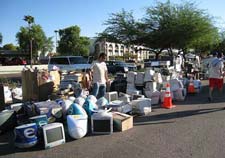 E-waste It would be easy to point the finger at Government, wring our hands (which is quite a feat while pointing the finger at the same time, but hey, let’s try) and say ‘how have we come to this? Where was the planning? We have nowhere to send out trash! Why did it get to critical?’ While there is certainly validity in this view (and Government needs to answer these questions), we need to turn that finger on ourselves and ask ‘what can I do to help? This is MY waste we are trying to deal with, why am I throwing all of this away?” Why are only 25% of us recycling? But come on Bermuda, let’s be creative. To get back to the question in the title, it is pretty clear that there is no “away”, most of it stays right here. One of the members of Greenrock’s Green Buildings Forum recently did a waste audit in their office, and found that the great bulk of the waste is single use plastic water bottles. Why do we need these? Fill up at home! Bring your bottle to work, or school, or town, and fill up again! Greenrock is working with the Corporation of Hamilton to install water bottle filling stations throughout Hamilton, but bringing the stuff you drink from home works just as well. What are plastic bags for? The average useful life of a plastic bag, from the store to the garbage bin at home, is 13 minutes. Is that really worth it? We have demonstrated that we don’t really need them in the grocery stores, why have them anywhere? Ban the bag! Let’s take a look at packaging … do we need our sandwich wrapped in plastic, then in a plastic clamshell, then in a plastic bag? How long is the useful lifespan of the plastic container in which we get our salad?
E-waste It would be easy to point the finger at Government, wring our hands (which is quite a feat while pointing the finger at the same time, but hey, let’s try) and say ‘how have we come to this? Where was the planning? We have nowhere to send out trash! Why did it get to critical?’ While there is certainly validity in this view (and Government needs to answer these questions), we need to turn that finger on ourselves and ask ‘what can I do to help? This is MY waste we are trying to deal with, why am I throwing all of this away?” Why are only 25% of us recycling? But come on Bermuda, let’s be creative. To get back to the question in the title, it is pretty clear that there is no “away”, most of it stays right here. One of the members of Greenrock’s Green Buildings Forum recently did a waste audit in their office, and found that the great bulk of the waste is single use plastic water bottles. Why do we need these? Fill up at home! Bring your bottle to work, or school, or town, and fill up again! Greenrock is working with the Corporation of Hamilton to install water bottle filling stations throughout Hamilton, but bringing the stuff you drink from home works just as well. What are plastic bags for? The average useful life of a plastic bag, from the store to the garbage bin at home, is 13 minutes. Is that really worth it? We have demonstrated that we don’t really need them in the grocery stores, why have them anywhere? Ban the bag! Let’s take a look at packaging … do we need our sandwich wrapped in plastic, then in a plastic clamshell, then in a plastic bag? How long is the useful lifespan of the plastic container in which we get our salad?
Our island is facing a trash crisis, and it is our responsibility, we are the ones throwing it away. Let’s make a commitment to reduce our trash, because ‘away’ is right here at home on our island.
The second article in this series will look at innovative public/private partnerships which can help resolve some of our trash issues.
*The information cited in this article from Works and Engineering comes from the Tynes Bay Waste to Energy Facility Third Stream Scoping Report.
Ed's Note: For government guidelines on the safe disposal of all household and commercial waste and recycling in Bermuda, click here to visit The Government of Bermuda's official Waste Management website.

